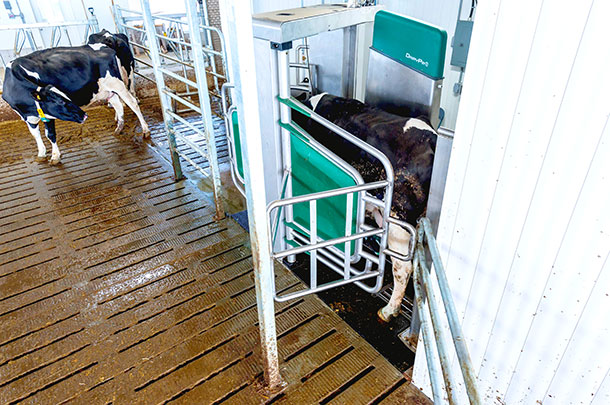When it comes to robotic milking systems, the more complex your barn design, the more complex the accompanying manure system can be. You have to consider how your manure system fits with cow flow, robot placement, resting spaces, feedbunks and more.
But no matter what type of robotic barn you have, these three things can help streamline the process and make sure your manure removal system works for you:
- Automation: Automated manure removal will minimize the amount of disruption to cow flow, which can negatively impact milking times and production levels. It also reduces labor and consistently keeps the barn and cows clean, no matter your schedule.
- Reliable equipment: Choose manure equipment that is high-quality and requires little maintenance. Constant repairs to manure equipment can disrupt cow flow and cause you headaches.
- Dependable dealers: A trustworthy, dependable dealer can make all the difference in your manure system. Make sure to choose a dealer with the knowledge and training to answer any questions and has a service program in place to perform regular maintenance.
It’s critical to get the key players on the same page from the beginning to ensure seamless integration of your manure system into your overall barn design. Early planning and excellent communication between experts in all areas of the barn design will keep everything working smoothly.
Here are some common questions we receive, and our individual answers based on our own expertise in manure management, automated milking and barn equipment.

Q: How do manure, automation and barn equipment work together in the planning phase?
SANFORD: Farmers need to decide what type of manure collection system will work best for the overall barn layout. Alley scrapers are usually the best choice for robot barns, but you also need to decide on the drive type – chain, cable or hydraulic. Once you have your manure system, work with your automation and barn equipment experts to make sure it flows with cow traffic and robot placement.
ROBERTS: In the planning phase, make sure you are considering how your manure system and robot placement work together to give cows the best access to the robot without disrupting manure collection. Cows must be able to enter the robot safely, comfortably, cleanly and efficiently.
MARTIN: Cow flow is an essential factor to consider – how are cows going to access the robot, feedbunk and resting areas? Cows in a robotic system aren’t out of the barn for extended periods, and manure must be managed around them. Cow flow and manure management must work together to keep cows comfortable and the barn clean.
Q: What’s the best first step when planning a new or retrofitted barn design?
SANFORD: Take your time to pick the right partners before planning begins. Make sure you use the right experts, ask for their opinions and see what connections and recommendations they have and how they will work with your team. Then get all your consultants together to start planning.
ROBERTS: I like to see farmers start planning one to two years before you dig the dirt. It’s important to see robots working every season of the year. More time to think and plan allows you to make logical decisions and end up with a facility that works for you and your cows.
MARTIN: Tour, tour, tour. Listen to advice from other robotic dairy farmers who’ve been in your shoes. Collect the best ideas and tailor them to work for what you want.
Q: Who should be involved in the planning from the start?
SANFORD: One group to make sure you aren’t overlooking in the planning process is your employees that will be working in the new barn, no matter how small the job. Their input can be hugely beneficial for efficient operation and workflow.
ROBERTS: Involve your equipment dealer early on – the sooner, the better – to help you find a system that fits your farm’s specific needs and identify any challenges. If you’re going to build a barn, one of the first people involved should be your financial adviser.
MARTIN: Involve farm owners, herd managers, contractors, vendors and equipment specialists from the very beginning.
Q: What makes a barn design project successful?
SANFORD: It boils down to communication and hard work. Working together from the beginning forms relationships that will keep everyone pushing forward to a successful installation.
ROBERTS: Teamwork between milking, barn equipment, manure, contractors and others from the very beginning sets you up for success. That way all ideas are more seamlessly integrated together for the best barn layout possible.
MARTIN: I think the number one thing is a high level of communication and excellent preplanning to ensure the whole team is working together. Each area involved in barn design has specific requirements for equipment and layout. Successful barn designs start by planning well in advance and having all phases of the project working together towards a common end goal.
Integrating your manure system with the whole robotic milking facility through automation, high-quality equipment, dependable dealers and teamwork through a careful planning process will help you de-stress and keep your new barn on the track to success. ![]()
PHOTO 1: Automation can help simplify your manure removal system in a robotic barn.
PHOTO 2: Robot placement and manure removal systems must work together to ensure a clean, comfortable barn. Photos courtesy of GEA.








